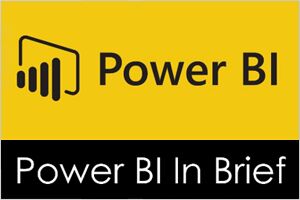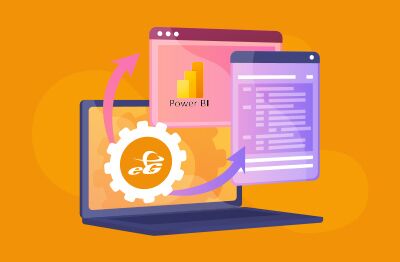What is Microsoft Power BI?
 Microsoft Power BI is a business analytics solution providing interactive visualizations and business intelligence capabilities from data and provides an interface that is simple enough for admins to create their own reports and dashboards. Data inputs to Power BI can come from multiple sources – Excel worksheets, CSV files, database tables, log files, the web, etc. It then employs smart visualizations and built-in AI technologies on that data to turn it into interactive insights.
Microsoft Power BI is a business analytics solution providing interactive visualizations and business intelligence capabilities from data and provides an interface that is simple enough for admins to create their own reports and dashboards. Data inputs to Power BI can come from multiple sources – Excel worksheets, CSV files, database tables, log files, the web, etc. It then employs smart visualizations and built-in AI technologies on that data to turn it into interactive insights.
eG Enterprise is a converged application and infrastructure performance monitoring solution that collects hundreds of thousands of performance metrics across every layer and every IT tier. Users of eG Enterprise are looking for different ways to visualize the performance data collected by it. While the built-in reporting console in eG Enterprise offers a wide variety of reports, administrators may still want to analyze and present the data in different ways. This is where Microsoft Power BI can be used.
This blog discusses how Microsoft Power BI can be integrated with eG Enterprise and how administrators can use the integration to get new perspectives on IT performance, thus empowering them to make intelligent and well-informed performance/business decisions.
eG Enterprise v7 now supports integration with Power BI
You can run queries on the Oracle/Microsoft SQL server backend of your eG installation to extract data from it and then convert the data into a format that Power BI supports – eg., CSV, XLS, JSON, XML. The smarter alternative is to use the eG Enterprise Command Line Interface (CLI). You can install the lightweight eG CLI software on any Unix/Windows host in your environment and quickly configure it to connect to the eG manager.
Using the CLI, you can then run commands on the manager to pull any type of data – be it raw measurement data, trend data, and even threshold data — from the eG backend and save it as a CSV / XML / TXT file, which can then be ported to Power BI. Power BI is also built with specialized connectors, which allow you the flexibility to connect to any data source directly from the Power BI Desktop and pull the data you want from it.
Once the data you need is available on the Power BI Desktop, you can use the editing tools that Power BI provides to transform the data to suit your needs. For instance, you can remove columns you do not want from a database table, pull data from other tables, sort the data, and so on. This way, you can play around with the extracted data, so that it is in a form that can be used to generate the report that you desire. Then, using Power BI’s reporting/visualization engine, quickly build the performance reports you want.
- Publish the custom reports to the Power BI Service and build new visualizations and dashboards using the reports. For example, using Power BI Desktop, you may have created many Alert Distribution reports for your Citrix application/desktop delivery service, each plotting the count of alerts across your Citrix infrastructure by day, by hour, and even by measure.
- With Power BI Service, you can pool these reports to create a single dashboard. If required, you can even add a custom tile/visualization to that dashboard – say, a tile that displays the number of alerts currently open across the Citrix service. With that, you have a single dashboard that allows both real-time and historical event analysis. These appealing and refreshing visual representations provide you with unique perspectives to Citrix service performance, thus enabling you to isolate ‘weak spots’ and their root-cause in no time!
Similarly, if you have a report each for every Citrix logon simulator at work in your environment, then, within minutes, you can stitch all these reports together to create a comprehensive Logon Simulator dashboard. Once you stitch these reports into a single dashboard (using Power BI Service), you have a central interface that provides you with all the information you need to efficiently evaluate Citrix logon performance. A quick look at this dashboard can point you to the precise simulation – i.e., the unique combination of simulator, XenApp/XenDesktop broker, and application/desktop – that has experienced the maximum number of logon failures, or the slowest logon, over time.
With Power BI, you can even intelligently tie the performance data from eG Enterprise with business data (e.g., revenue and penalties can be combined with SLA violations) gathered from other sources, so decision-makers can accurately analyze how performance degradations are impacting their bottom line.
| How to implement the eG Enterprise/Microsoft Power BI Integration: This involves the simple steps below:
|
Discover Business Insights Right Away
The eG Enterprise-Power BI alliance benefits different stakeholders with different analytical needs.
eG Enterprise is an Observability solution for Modern IT. Monitor digital workspaces,
web applications, SaaS services, cloud and containers from a single pane of glass.
Customers can run health checks on their mission-critical systems and servers each month using eG Enterprise, and then export the performance results to Power BI for quick month-over-month analysis for effectively comparing performance across months.
- Disturbing performance trends (if any) can be rapidly captured using these insights.
- Service Providers can leverage the graphical capabilities of Power BI to instantly build reports and dashboards depicting the overall performance of a customer environment during different timelines. These visualizations can then be presented to that customer to enable a detailed slice-and-dice analysis of performance.
- Administrative staff can export performance metrics collected before and after an OS migration or hot fix/patch application to Power BI. They can then create intuitive comparative views in Power BI to understand how the migration/bug fix has impacted different KPIs.
- Service managers can pick and choose the service metrics they want to audit in real-time and selectively export them to Power BI along with their thresholds.
- Real-time service dashboards can be configured using Power BI, which will enable service managers to capture SLA slippages on-the-fly! This means that both online and offline analysis of performance data can be achieved by integrating eG Enterprise with Power BI.
See your data the way you want!
- Unparalleled flexibility in generating graphs, reports, and dashboards
- Transforming your raw performance data into actionable information within minutes, so you can take the right performance decision for your critical IT services.
- Understanding the business impact of your performance decisions, so you can do what is right for your business!
- Sharing, viewing, and studying performance dashboards ‘on-the-go’, using Power BI Mobile Apps



